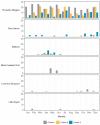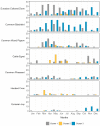Study of the Interface between Wild Bird Populations and Poultry and Their Potential Role in the Spread of Avian Influenza
- PMID: 37894259
- PMCID: PMC10609042
- DOI: 10.3390/microorganisms11102601
Study of the Interface between Wild Bird Populations and Poultry and Their Potential Role in the Spread of Avian Influenza
Abstract
Water birds play a crucial role in disseminating and amplifying avian influenza viruses (AIVs) in the environment. However, they may have limited interactions with domestic facilities, raising the hypothesis that other wild birds may play the bridging role in introducing AIVs into poultry. An ornithocoenosis study, based on census-transect and camera-trapping methods, was conducted in 2019 in ten poultry premises in northeast Italy to characterize the bird communities and envisage the species that might act as bridge hosts for AIVs. The data collected were explored through a series of multivariate analyses (correspondence analysis and non-metric multidimensional scaling), and biodiversity indices (observed and estimated richness, Shannon entropy and Pielou's evenness). The analyses revealed a high level of complexity in the ornithic population, with 147 censused species, and significant qualitative and quantitative differences in wild bird species composition, both in space and in time. Among these, only a few were observed in close proximity to the farm premises (i.e., Magpies, Blackbirds, Cattle Egrets, Pheasants, Eurasian Collared Doves, and Wood Pigeons), thus suggesting their potential role in spilling over AIVs to poultry; contrarily, waterfowls appeared to be scarcely inclined to close visits, especially during autumn and winter seasons. These findings stress the importance of ongoing research on the wild-domestic bird interface, advocating for a wider range of species to be considered in AIVs surveillance and prevention programs.
Keywords: HPAI; bridge hosts; camera trap; ornithocenosis; ornithological transects; spillover; wild birds; wild–domestic interface.
Conflict of interest statement
The authors declare no conflict of interest.
Figures







Similar articles
-
Characterizing the domestic-wild bird interface through camera traps in an area at risk for avian influenza introduction in Northern Italy.Poult Sci. 2024 Aug;103(8):103892. doi: 10.1016/j.psj.2024.103892. Epub 2024 May 23. Poult Sci. 2024. PMID: 38865769 Free PMC article.
-
Bridge hosts for avian influenza viruses at the wildlife/domestic interface: an eco-epidemiological framework implemented in southern Africa.Prev Vet Med. 2014 Dec 1;117(3-4):590-600. doi: 10.1016/j.prevetmed.2014.09.014. Epub 2014 Oct 18. Prev Vet Med. 2014. PMID: 25457135
-
Genetic and Pathogenic Characterization of Avian Influenza Virus in Migratory Birds between 2015 and 2019 in Central China.Microbiol Spectr. 2022 Aug 31;10(4):e0165222. doi: 10.1128/spectrum.01652-22. Epub 2022 Jul 12. Microbiol Spectr. 2022. PMID: 35862978 Free PMC article.
-
Prevalence, Seroprevalence and Risk Factors of Avian Influenza in Wild Bird Populations in Korea: A Systematic Review and Meta-Analysis.Viruses. 2023 Feb 8;15(2):472. doi: 10.3390/v15020472. Viruses. 2023. PMID: 36851686 Free PMC article.
-
[An overview of surveillance of avian influenza viruses in wild birds].Bing Du Xue Bao. 2014 May;30(3):310-7. Bing Du Xue Bao. 2014. PMID: 25118388 Review. Chinese.
Cited by
-
Knowledge, attitudes, and practices regarding avian influenza among poultry farmers near migratory bird habitats in Guidong County, China.Front Public Health. 2025 Jun 17;13:1618292. doi: 10.3389/fpubh.2025.1618292. eCollection 2025. Front Public Health. 2025. PMID: 40600158 Free PMC article.
-
Seasonal changes in bird communities on poultry farms and house sparrow-wild bird contacts revealed by camera trapping.Front Vet Sci. 2024 Feb 20;11:1369779. doi: 10.3389/fvets.2024.1369779. eCollection 2024. Front Vet Sci. 2024. PMID: 38444782 Free PMC article.
-
Integrating Citizen Science and Remote Sensing Data to Identify Key Environmental Factors Influencing H5N1 Avian Influenza Virus Potential Spillover Risk in the Philippines.Geohealth. 2025 Aug 7;9(8):e2025GH001405. doi: 10.1029/2025GH001405. eCollection 2025 Aug. Geohealth. 2025. PMID: 40777847 Free PMC article.
-
Quantitative Risk Assessment of Wind-Supported Transmission of Highly Pathogenic Avian Influenza Virus to Dutch Poultry Farms via Fecal Particles from Infected Wild Birds in the Environment.Pathogens. 2024 Jul 8;13(7):571. doi: 10.3390/pathogens13070571. Pathogens. 2024. PMID: 39057798 Free PMC article.
-
Investigation of human infection with H5N6 avian influenza cases in Sichuan Province from 2014 to 2024: a retrospective study.Front Public Health. 2025 Jun 6;13:1603158. doi: 10.3389/fpubh.2025.1603158. eCollection 2025. Front Public Health. 2025. PMID: 40547469 Free PMC article.
References
-
- Mulatti P., Ferrè N., Marangon S. Spatial Distribution of 2000-2007 Low Pathogenicity Avian Influenza Epidemics in Northern Italy. In: Majumdar S.K., Brenner F., Huffman J., McLean R., Panah A., Pietrobon P., Keeler S., Shive S., editors. Pandemic Influenza Virus. Pennsylvania Academy of Science; East Stroudsburg, PA, USA: 2010. pp. 232–247.
-
- Fornasiero D., Fusaro A., Zecchin B., Mazzucato M., Scolamacchia F., Manca G., Terregino C., Dorotea T., Mulatti P. Integration of Epidemiological and Genomic Data to Investigate H5N1 HPAI Outbreaks in Northern Italy in 2021–2022. Pathogens. 2023;12:100. doi: 10.3390/pathogens12010100. - DOI - PMC - PubMed
-
- Mulatti P., Fusaro A., Scolamacchia F., Zecchin B., Azzolini A., Zamperin G., Terregino C., Cunial G., Monne I., Marangon S. Integration of genetic and epidemiological data to infer H5N8 HPAI virus transmission dynamics during the 2016–2017 epidemic in Italy. Sci. Rep. 2018;8:18037. doi: 10.1038/s41598-018-36892-1. - DOI - PMC - PubMed
LinkOut - more resources
Full Text Sources

